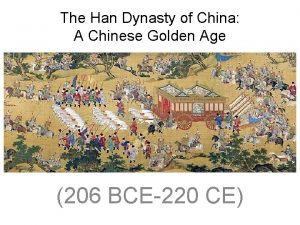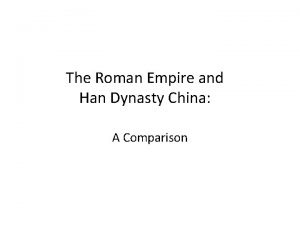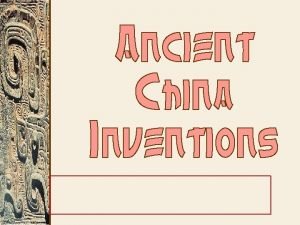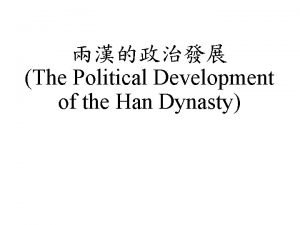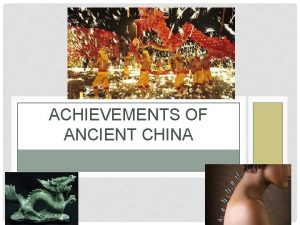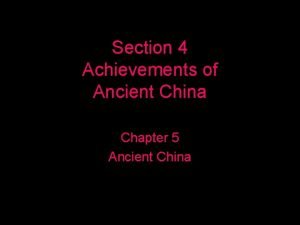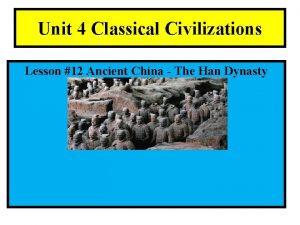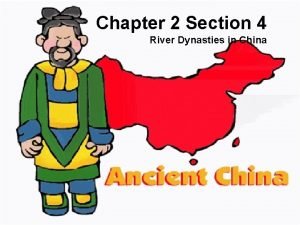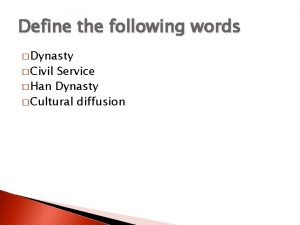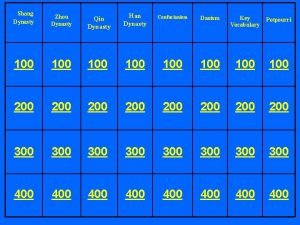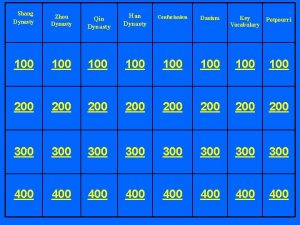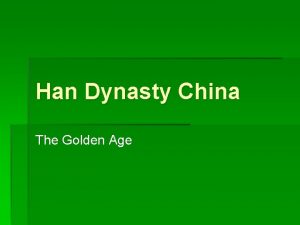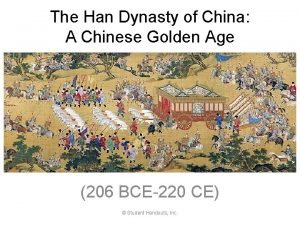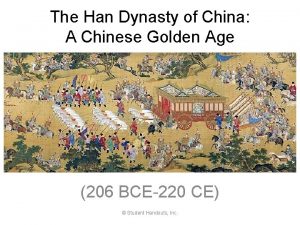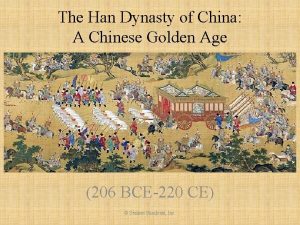The Han Dynasty of China A Chinese Golden













- Slides: 13

The Han Dynasty of China: A Chinese Golden Age (206 BCE-220 CE) © Student Handouts, Inc.

Historical Setting of the Han • Followed the Qin dynasty • WHAT ARE 3 CHARACTERISTICS OF THE QIN DYNASTY? – 221 -206 BCE – Qin ended in rebellion and civil war due to weak ruler and unrest (206 -202 BCE) • Han dynasty was China’s second imperial dynasty – 206 (or 202) BCE-220 CE • Over 400 years

Liu Bang – Emperor Gaozu of Han • 202 BCE – Liu Bang beat Xiang Yu for good after a Civil War • Liu Bang declared start of Han dynasty Two Periods of the Han Dynasty • Former Han – Also called the Western Han – 206 BCE-9 CE • Interrupted by the Xin dynasty – Under Wang Mang – 9 -23 CE • Later Han – Also called the Eastern Han – 25 -220 CE Liu Bang reigned 202 BCE-195 BCE.

Technology under the Han Paper Collar harness Plow Wheelbarrow Waterwheel • Invented in 105 CE • Books became inexpensive to produce; expanded education • Bureaucracy grew and became more efficient • Horses could carry heavier loads • Best harness available at the time worldwide • The Chinese made one with two blades • Much more efficient • Invented independently (Greeks had invented as well) • Central wheel and axle let Chinese wheelbarrows carry very heavy weights • Used to power things such as the bellows for smelting iron

Government under the Han • Centralized government • Lowered taxes • Less harsh punishments Please read source A of your handout and address the question in groups (everyone must address the question in 1 -2 sentences).

Bureaucracy under the Han • Taxes supported the government and military • Merchants – Paid taxes • Peasants – Gave the government a portion of their annual crops – Each year gave a month of labor (for public works projects) or of military service

Map of the Silk Road • Why is the name Silk Road significant?

Silk Roads under the Han • Trade routes across Asia – To Mediterranean (access to Europe) in the west • Chinese silks were sold in the marketplaces of the ancient Roman empire • Traded silk and other goods • Cultural diffusion Please take a look at SOURCE B and address the question in 1 -2 sentences.

Commerce and Trade under the Han • Trade and commerce were not respected but were still very important • Government had monopolies – Salt mining – Iron forging – Coin minting – Alcohol brewing • Government engaged in industry – Silk weaving • Growth of trade along the Silk Roads

Social Classes under the Han Emper or Governor s and Nobles, Kings Scholars, and State Officials Peasants (Farmers) Artisans and Merchants Soldiers Slaves Please take a look at SOURCE C and address the questions in 1 -2 sentences.

Agriculture under the Han • Population of 60, 000 to be fed • Farming thought to be a pivotal and honored occupation • But in reality small farmers were burdened by government taxes and became heavily indebted to the rich Ancient Chinese wheelbarrow

Rich vs. Poor • Inheritance law was the root cause of the problem – Land divided among male heirs (sons) – Reduced the size of plots with each generation – Small farmers couldn’t support themselves and had to borrow money – Decreased tax revenue for the government

Roles of Women under the Han Women with Power Traditional Roles • Confucianism limited women to the home and to subservience to men (fathers, husbands, sons) • Women worked hard for their families with little reward • Some women wielded political power because of court alliances • e. g. , Empress Lu • Nuns • Educated • Lived apart from families • Medicine practitioners • Shop managers • Writers Paradox? • Ban Zhao • Helped finish her father’s History of the Former Han Dynasty • Wrote Lessons for Women • Urged women to obey the Confucian social order • Also encouraged women to be industrious • Went against convention by writing professionally
 Han dynasty golden age
Han dynasty golden age Both the han dynasty and the roman empire
Both the han dynasty and the roman empire The ming dynasty ended rule of china.
The ming dynasty ended rule of china. Qin dynasty innovations
Qin dynasty innovations Han dynasty
Han dynasty Chinese dynasty acrostic poem
Chinese dynasty acrostic poem Han dynasty achievements
Han dynasty achievements Good afternoon please
Good afternoon please Achievements of ancient china
Achievements of ancient china Spice t
Spice t Social classes of china
Social classes of china Han dynasty crossbow
Han dynasty crossbow Chapter 2 section 4 river dynasties in china
Chapter 2 section 4 river dynasties in china Han dynasty civil service
Han dynasty civil service
